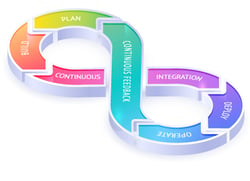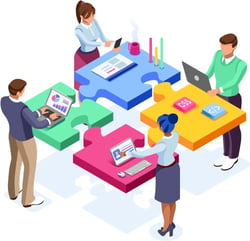Developing new products that customers love is a challenge but a rewarding one when your team gets it right. Moving from the initial idea to the production and release of the product requires strategy and some type of framework. In product development, a company can take choose from a handful of approaches to build and develop new products. The most commonly used approaches include stage-gate, agile, and hybrid systems. This article will delve into these three methods and determine where they are most suitable.
The Stage-Gate Approach
 The stage gate approach, also known as phase-gate or the waterfall methodology, is a product management technique where the product is divided into stages, separated by gates. At each gate, the product must be assessed and approved by product managers and executives as to whether the product should continue to the next stage of development.
The stage gate approach, also known as phase-gate or the waterfall methodology, is a product management technique where the product is divided into stages, separated by gates. At each gate, the product must be assessed and approved by product managers and executives as to whether the product should continue to the next stage of development.
It is important to plan comprehensively during the early stages. This includes outlining all necessary steps, associated costs, and projected revenues before gaining approval for the product.
Stage-gate has five main phases, each separated by a checkpoint or gate. These phases include:
- Generating the product idea
- Defining the product scope
- Presenting the business case
- Developing the product
- Launching the product
The Benefits of Using Stage-Gate
The stage-gate product development methodology offers several advantages to the organization. One key feature of stage-gate is the development of a fully-fledged prototype as a means of testing and improving the product. This is beneficial as it offers consumers and stakeholders first-hand experience of the full version of the product for testing and feedback. This bears contrast to the agile approach, which uses an MVP for continuous testing and iteration.
Stage-gate also provides structure by breaking down the development process into distinct stages and coupling them with specific objectives that need to be met before moving on to the next stage. Although the stage-gate process may seem inflexible, it offers predictability through product roadmaps, as development teams are fully aware of the tasks required and the order in which they should be completed to produce the final product.
Why Use The Stage-Gate Approach?
This approach minimizes uncertainty and reduces the likelihood of surprises during the development process. By breaking the process into several defined stages, there is an opportunity to assess any risk and put mitigation measures in place where needed. This proactive approach helps to reduce the risk of failures further into the process.
The inclusion of gates after each phase allows project stakeholders to evaluate progress and make decisions that affect how development proceeds in the next stage. Whether you should still use stage-gate depends on your company structure and vision for the future.
The Agile Framework
 The agile product development method offers a more dynamic approach that prioritizes immediate needs and avoids extensive upfront planning. The focus, when using this method, is continuous improvement while building the product.
The agile product development method offers a more dynamic approach that prioritizes immediate needs and avoids extensive upfront planning. The focus, when using this method, is continuous improvement while building the product.
One of the key features of an agile methodology is that this approach supports adaptability and encourages flexibility. Agile principles allow for changes in the product strategy as new insights arise and accommodate alignment with the company vision as it evolves.
The agile method offers several advantages, such as the following:
- Prioritizes short-term goals and budgets over traditional long-term planning and approval processes for product development.
- Divide projects into smaller tasks for cost control and flexibility to pivot or terminate if issues arise.
- Helps your teams make informed decisions and avoid committing too many resources to a project at the beginning.
Agile vs. Stage-Gate
When deciding which product development process to use, much depends on the type of product. Simple products may work well with stage-gate methodology. These products are typically not affected by markets and technology, and product development works well within a rigid framework.
In contrast, when developing new innovative products, agile is preferable. Agile roadmaps support innovation by offering several iterative cycles for testing and feedback. This allows for continuous development along the way.
The Hybrid Model
 Organizations can incorporate agile practices gradually in what is termed a “hybrid” approach.
Organizations can incorporate agile practices gradually in what is termed a “hybrid” approach.
A hybrid approach to development combines the best of both practices. It also offers a smoother transition by introducing new elements rather than abruptly shifting to agile. This slower, more deliberate move ensures that implementation is likely to be successful.
The shift from stage-gate to agile may include introducing the following elements:
Shift From a Prototype to an MVP
Developing a minimum viable product instead of a fully-fledged prototype is a more efficient way to develop great products. This is not only less expensive but allows the team to test and improve each feature before moving on to the next. The aim is that with this process of continuous improvement, the product is tested and improved as many times as needed to create the best product.
Shift to Continuous, Cross-Functional Teams
A more efficient approach when organizing personnel is to have a continuous agile team that oversees the entire product lifecycle instead of assembling temporary teams for each project. In such cases, the same team launches and develops the product over time. This is ideal as the original team has a better understanding of their product and process, providing deeper insights into potential new features to be developed over time.
Incorporating Value Stream and Participatory Budgeting
Instead of following a project by project funding approach to annual project planning and budgeting, value stream budgets and participatory budgets bring more flexibility to the process. They fund a work stream as long as it brings value and maximizes productivity by removing idle times in introducing and managing new product development initiatives.
The shift to value-stream budgets ensures that budgets are allocated to funding actions and activities that deliver value to the consumer. Participatory budgets support the idea that budgeting should be a collaborative and participatory process; those who are most familiar with the work and understand which features and activities will generate value actively participate in the budgeting process.
As long as a team is providing value and meeting objectives, they will get funded. There is no need to put a team together for each project and then dismantle them to put on another.
Get Your Internal Stakeholders on the Board
For any change to be successful, a product manager must get the company executives and their product teams on board. This takes time and careful planning to accomplish and can be assisted by incorporating the following:
- Include a period of education to update teams on why the proposed change is happening.
- Explain the benefits and the objectives of incorporating these new processes.
- Provide opportunities for discussion and feedback so project teams can assess how the new changes will affect their work.
It will take time to adjust these processes not only on a team level but on a collaborative level, too. To ensure a smooth transition, it may be necessary to hold regular team meetings to stay on top of the changes. This will also help to establish stronger relationships between product teams.
The Benefits of Product Roadmaps For Hybrid Development
Product roadmaps are useful to relay change and track progress over time. They provide a single source of truth that all team members can align to and use as a guide to pursue their own tasks. If you would like to find out more about how Gocious product roadmap management software can help your business navigate change, book your free demo today!


